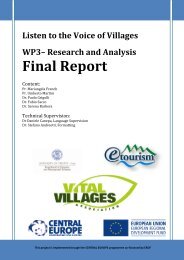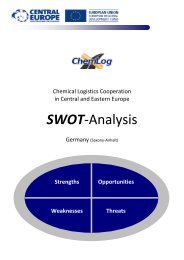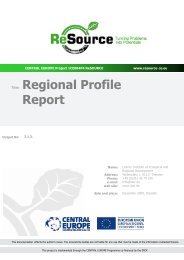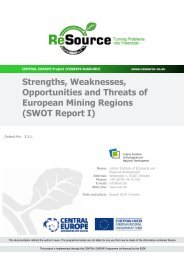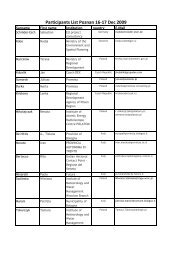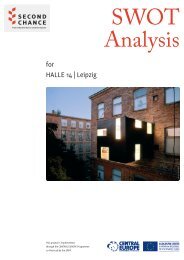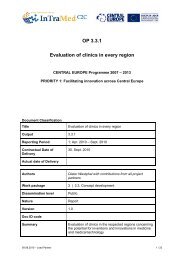Mainly on the Elbe River - Central Europe
Mainly on the Elbe River - Central Europe
Mainly on the Elbe River - Central Europe
You also want an ePaper? Increase the reach of your titles
YUMPU automatically turns print PDFs into web optimized ePapers that Google loves.
2.2.3.1 The navigati<strong>on</strong> degree Děčín will not be c<strong>on</strong>structed<br />
The navigati<strong>on</strong> period will shorten to <strong>on</strong>ly 203 days (calculated as a difference 345-142 days per<br />
year with insufficient permitted draft). Due to fluctuati<strong>on</strong>s in water levels (water flow), <strong>on</strong>ly<br />
<strong>the</strong> average load of 800 t<strong>on</strong>s per vessel can be taken into account. The maximum transport volume<br />
is <strong>the</strong>refore 2.600 thousand t<strong>on</strong>s in <strong>on</strong>e directi<strong>on</strong>. Utilizati<strong>on</strong> of water transport for <strong>on</strong>ly 203 days of<br />
unwarranted navigati<strong>on</strong>, i.e. unwarranted delivery dates, causes lower interest of transporters. As a<br />
result, <strong>the</strong> real capacity usage is <strong>on</strong>ly 535.500 t<strong>on</strong>s and 669 vessels in both directi<strong>on</strong>s per year.<br />
The daily average is 3 vessels in both directi<strong>on</strong>s during <strong>the</strong> navigati<strong>on</strong> period.<br />
2.2.3.2 The navigati<strong>on</strong> degree Děčín will be c<strong>on</strong>structed<br />
Navigati<strong>on</strong> will be possible 345 days per year at least from <strong>the</strong> port Děčín Rozbělesy and in<br />
combinati<strong>on</strong> with river upheaving, to all ports <strong>on</strong> <strong>the</strong> <strong>Elbe</strong> and Vltava rivers. During <strong>the</strong> remaining<br />
122 days, capacity will be lowered due to insufficient capacity of <strong>the</strong> Děčín port and <strong>the</strong> related<br />
routes to 6 vessels per day. This corresp<strong>on</strong>ds with <strong>the</strong> possible maximum of 8.600 vessels per<br />
year in both directi<strong>on</strong>s. Regarding <strong>the</strong> greater vessel loads, <strong>the</strong> maximum transported volume will<br />
be 8.014 thousand t<strong>on</strong>s in both directi<strong>on</strong>s.<br />
2.2.3.3 The navigati<strong>on</strong> degree Děčín will be c<strong>on</strong>structed and <strong>the</strong> c<strong>on</strong>diti<strong>on</strong>s for<br />
navigati<strong>on</strong> between Boletice and Střekov will be solved<br />
In this case, fulltime navigati<strong>on</strong> will be ensured 345 days per year. This means 345*16 = 5.520<br />
per year in <strong>on</strong>e directi<strong>on</strong>. Calculating <strong>the</strong> average load 600 t<strong>on</strong>s for 142 days per year and 1.000<br />
t<strong>on</strong>s for 203 days per year, <strong>the</strong> maximum transport volume will be following:<br />
203*16*1000 + 142*16*600 = 4.611.200 t<strong>on</strong>s in <strong>on</strong>e directi<strong>on</strong>, or 9.222.400 t<strong>on</strong>s in both<br />
directi<strong>on</strong>s.<br />
2.3 CHEMICAL INDUSTRY PRODUCTION<br />
2.3.1 The <strong>Europe</strong>an Uni<strong>on</strong><br />
Chemical industry, plastic and rubber producti<strong>on</strong> bel<strong>on</strong>g am<strong>on</strong>g <strong>the</strong> largest and <strong>the</strong> most<br />
dynamic industries in <strong>the</strong> EU. Toge<strong>the</strong>r, <strong>the</strong>y produce approximately 3,2 milli<strong>on</strong> of working places<br />
in more than 60.000 companies. In 2007, sales of chemicals reached in EU <strong>the</strong> total amount of 537<br />
billi<strong>on</strong> EUR. The EU is am<strong>on</strong>g <strong>the</strong> world’s largest producers of chemicals. Statistical data show<br />
c<strong>on</strong>stant growth of chemical producti<strong>on</strong> volumes during <strong>the</strong> past years. In <strong>the</strong> EU 15, <strong>the</strong> total<br />
chemical producti<strong>on</strong> grew by 22 % between <strong>the</strong> years 1996 - 2007. Producti<strong>on</strong> of toxic chemicals<br />
grew by 18 % between 1996 - 2005, <strong>on</strong>ly <strong>the</strong> slight decrease by 3 % appeared in 2006/2007. The<br />
main c<strong>on</strong>sumers of chemicals are metallurgy, machine-building, electrical and electr<strong>on</strong>ic industry,<br />
textile, clothing, car, paper and printing industries.<br />
A feasibility study for “Improvement of C<strong>on</strong>diti<strong>on</strong>s for <strong>the</strong> <strong>River</strong> Transport in <strong>Central</strong> <strong>Europe</strong> (mainly <strong>on</strong> <strong>the</strong> <strong>Elbe</strong><br />
<strong>River</strong>)“ realized within <strong>the</strong> ChemLog project 27




